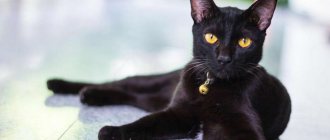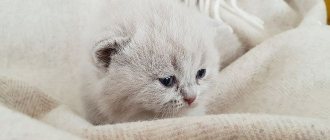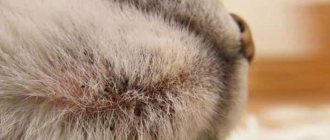Glamorous, bohemian Englishwomen, with a refined, light ballerina gait - these are the epithets that are awarded to the cat breed with the English name Cornish Rex, translated into Russian it sounds like Cornish Rex. When getting acquainted with the breed, this miracle of nature, at first there is bewilderment at the unusual shape of the body, curly hair, long legs, with a slightly elongated muzzle, and a flexible tail. Having looked at them closely, having studied their character, they recognize their unconditional primacy at the world feline beauty contest, where representatives of this species are the main contenders for medals of the highest merit.
The peculiarity of cats of the Cornish Rex breed, in addition to their unusual appearance, is considered to be their capricious, playful character, curiosity, cleanliness, and puppy-like loyalty to the owner. Funny Cornish Rex kittens, with soft astrakhan fur, become family favorites, especially among children.
Video
* We invite you to watch a video about the Cornish Rex . In fact, in front of you is a playlist in which you can select and watch any of 20 videos about a given cat breed by simply clicking on the button in the upper right corner of the window. In addition, the material contains quite a lot of photos. By looking at them you can find out what a Cornish Rex looks like.
Rate the material!
[Total votes: 1 Average: 5]
Cornish Rex cat breed was born not so long ago - only in the middle of the last century. Its representatives differ from other cats in their absolutely fantastic appearance, as well as short curly hair. In addition to the unusual coat, the image of graceful creatures is favorably complemented by expressive, intelligent eyes and rather large ears. These cats have a wonderful character, are gentle and playful, so fitting into any family is not a problem for them.
Kittens
Cornish Rex kittens purchased from the nursery are already vaccinated and trained to use the toilet and scratching post. The Rex kitten you want to buy must be at least 3 months old.
They, of course, are immediately different from ordinary kittens, but astrakhan fur appears in babies as they age. Kennels value their reputation and are fully responsible for the purity of the breed.
Since rexes belong to the bohemian breed, owners often give preference to a nickname that has a mystical origin. Let the kitten's name emphasize its unusualness. Nicknames with an aristocratic English sound are also perfect.
- For girls: Abigail, Bertha, Violetta, Denise, Frida.
- For boys: Jean, Hamlet, Walter, Willis, Cerberus.
In many nurseries, a kitten is bought with a nickname already included in the documents.
History of the origin of the Cornish Rex
The history of the Cornish Rex breed began in 1950 in Great Britain. Farmer Nina Ennismore suddenly discovered that among the kittens of a recently lambed cat, there was one with a very unusual appearance. What was unusual about the kitten was its curly fur and simply huge ears, which gave it an alien appearance. Ordinary kittens were soon distributed to neighbors, and the unusual kitten was left in the owner’s house and given the same unusual name - Kalinbuker.
Six months later, the farmer decided to castrate Kalinbooker, but the veterinarian, seeing how the cat looked, persuaded her not to do it. He suggested that the unusual pet could mark the beginning of a completely new breed. Nina Ennismore listened to the veterinarian and as a result of mating the cat Kalinbooker and the cat Serena (his mother), three more kittens were born, two of which looked like their father. Only one of them, who was named Poldu, survived to adulthood.
The English farmer's crossbreeding experiments continued for several more years and approximately half of the offspring from each litter were born with curly hair and large ears. A few years later, the farmer was overtaken by serious financial problems, because of which she stopped breeding curly-haired cats and euthanized her pets: the cat Serena and the cat Kalinbooker. The cat Pold managed to avoid a sad fate - he was bought, but then by mistake he was castrated. Fortunately, Poldu has several curly-haired descendants.
Interesting fact: One famous American cat lover, Frances Blanchery, managed to buy two Cornish Rex cats in England in 1957 - descendants of Pold. It was a red cat and a pregnant blue and white female. The woman took them to America, to her homeland. Soon the cat calved and there were two curly-haired kittens in the litter, from which the branches of the breed in the USA later originated.
For about 30 years, American breeders crossed Cornish Rexes with Burmese, Siamese and other shorthaired cats. Thanks to this, the breed not only acquired new colors, but also became very popular among cat lovers. The Cornish Rex breed was officially registered in 1983. It also officially recognized two lines - British and American.
Cornish Rex - description of the breed
Cornish Rex cats are usually not very large. An adult cat usually weighs 4–5 kg, and females even less. The animals look quite sophisticated and even elegant, but all their muscles are well developed. It is worth noting that the bone structure of the British line of the breed is somewhat heavier than that of the Americans.
According to the American standard, Cornish Rex cats look like this:
- Narrow and somewhat elongated body;
- Very developed muscle corset;
- Egg-shaped head;
- Wedge-shaped muzzle;
- Roman nose;
- High cheekbones;
- Strong jaws;
- Large cone-shaped ears;
- Large oval, slightly slanted eyes;
- Slightly arched back;
- Wide chest;
- Tight stomach;
- Thin, slender and long limbs (the front legs are shorter than the hind legs);
- Long and mobile whip-like tail;
- Soft curly coat without guard hairs and available in a wide variety of colors.
It is important to understand that the Cornish Rex breed has some similarities with the Devon Rex breed and it can be quite difficult for an inexperienced person to distinguish between these two cats. The difference here primarily lies in the shape of the head. For example, in the former it is ovoid, in the latter it is heart-shaped. Also, in the Cornish Rex, the nose blends more smoothly into the forehead.
There are also some differences in body structure. So, Devons have a shorter body and stronger bones. Another difference can be found if you carefully examine the fur of both cats. For example, in Cornish cats most of the hairs are curved downwards, while in Devon Rex hairs look tousled and directed upwards.
Standards
Refined grace is what comes to mind when looking at Cornish Rex cats. However, do not think that these creatures are fragile and pampered. Beneath the velvet coat are strong muscles and a strong bone structure. Cats weigh a little: females - 3-4 kg, males - no more than 5.
There are 2 types of standards: American and English. There are many similarities, but there are also differences. Moreover, the judges of both FIFe and WCF give preference to the first description.
| Standard | Description |
| Head | Egg-shaped (in the American species) or triangular (in the English species). The forehead is convex, rounded, the cheekbones are high and clearly defined. The chin is strong, the neck is strong, but thin. The jaws are powerful, the bite is correct (but a slight undershot is not considered a defect). |
| Ears | Very large, stand upright, rounded at the ends. Set wide apart. |
| Eyes | Oval, slanted, the iris is brightly colored, any color is allowed. |
| Torso | Elongated, strong, tucked belly, arched back, strong chest, there is a hint of a waist. The limbs are thin, which creates a clear contrast with the body. Paws are oval, fingers are long. |
| Tail | Long, tapering towards the tip, very mobile and flexible. |
| Wool | Very soft, feels like delicate silk. It fits tightly to the body (despite the complete absence of guard hairs) and lies in uniform waves. Curly hair is most severe in the abdomen, chest and chin. |
Significant disadvantages:
- Small ears.
- Wide or too long head.
- Massive stocky body.
- Bald patches on the body.
- Bald, shaggy or short tail.
An animal is removed from the competition if it is found to have:
- Deafness.
- Lameness.
- Undescended testicles.
- No claws.
- Tail with kinks or loops.
- Coat that is rough to the touch.
- Extra fingers.
Like all purebred cats, Cornish Rex cats are divided into 3 groups. Depending on which group the animal belongs to, its cost is determined.
Pet class kittens cost from 10 to 20 thousand rubles, breed class kittens (intended for breeding) - from 25 to 40 thousand rubles. The most expensive - show class kittens that successfully participate in various kinds of exhibition events - are more expensive than the rest (the price starts from 40 thousand).
Popular colors of Cornish Rex
Cats of the Cornish Rex breed have a rather unusual short, wavy and silky coat, similar to the fur coat of a young lamb. Thanks to crossing with other breeds, these cats have a great variety of colors.
Here are some of them:
- White color (pink nose and paw pads, golden or blue eyes);
- Black color (nose and paw pads are brown or black, golden eyes);
- Blue color (blue nose, golden eyes);
- Red and cream colors (nose and paw pads are light brown);
- Smoky-silver color (with dark areas like the colors of Siamese cats, eyes bluish or green);
- Black smoky color (similar to Burmese colors, nose and paw pads are black, green eyes);
- Bluish-smoky color (mask on the face and paws are blue, paw pads are pink);
- Tabby color is classic (paws are colored with dark rings, dark streaks on the sides, dark back);
- Tabby brindle (almost similar to the classic tabby color, but the letter “M” is drawn on the cat’s forehead with dark stripes);
- Tabby spotted (with spots of beige and reddish color);
- Brown spotted tabby (basic coat pattern is classic or brindle tabby on a brown background with spots of reddish and beige);
- Bluish-spotted tabby (brindle pattern on a beige background with a bluish tint);
- Blue spotted tabby (beige color with a blue tint with a dark blue tabby brindle pattern, bright golden eyes);
- Silver spotted tabby (brindle pattern on a silver background with spots, deep golden eyes);
- Silver tabby (classic or brindle pattern, brick-colored nose, bright green eyes);
- Red Tabby (brindle pattern on a reddish background, nose and paw pads terracotta color);
- Brown tabby (dark brindle stripes on a terracotta background, brick-colored nose, golden eyes);
- Blue or cream tabby (classic or brindle markings on a bluish or cream background);
- Tortoiseshell (reddish spots on a black background, dark nose, golden eyes);
- Calico (white background with dull reddish and black spots, blue, golden or bicolor eyes);
- Calico lightened (white background with beige and blue spots, golden eyes);
- Bluish-cream (blue background with rare small beige spots, golden eyes).
As for the popularity of one color or another, the fashion for them changes depending on the year. However, the so-called “pure” colors, without spots, are still more popular.
Character and habits of the Cornish Rex
Cornish Rex cats are very energetic, active and playful in nature. Even at a very old age, they love life and never stop looking for adventure. They like to explore the surrounding space, so it is not advisable to leave Cornish cats indoors for a long time. After all, not knowing where to put the excess energy, they will begin to climb curtains and walls, knock over pots of plants, scratch walls and furniture.
These cats are also very sociable and simply love to be the center of attention. For example, they often like to climb onto their owners’ laps, rub their muzzles against their arms, legs, face and purr, quite loudly, as if they are telling something.
Interesting fact: These animals are very friendly: living in the same house with dogs or other cats is not a problem for them at all, but on one condition - only they should get the lion's share of attention. If this is not the case, then the owners will be defiantly ignored for several days.
Cornish Rex are very partial to children and simply love to play with them. Parents of children should know that such a friendly pet will never allow itself to offend the baby, even if he does something wrong, for example, pulling the tail, touching the hind legs and belly. If unwanted actions on the part of the child are repeated, the Cornish Rex will not bite or scratch, but will simply avoid him, considering him a source of threat.
At first, Cornish Rex cats show distrust of strangers and allow themselves to be petted only when they feel completely safe. It is important to take into account one more point: these cats have a very developed hunting instinct, so it is not recommended to keep birds or rodents in the house where they live.
Interesting facts about the Cornish Rex
The main character traits of the Cornish Rex are very similar to dogs. They are also friendly, curious, and have a strong attachment to their owner, following on his heels.
Cornish Rexes are distinguished by intelligence, intelligence and high intelligence. They are much easier to train and train than other breeds. Therefore, with regular training with your pet, you can quickly teach him to fetch thrown objects, as well as to carry out dog commands: “lie down”, “sit”, “come to me”, “no”.
The curly coat of these cats, due to the lack of guard hairs, does not retain heat well, so it is advisable to buy warm houses for them along with beds. Also, due to their activity, a gaming complex would not be amiss.
Cornish wool is not an allergen. Cornish Rex cats have an acute sensitivity to anesthetics. Because of this, they tolerate anesthesia much harder than cats of other breeds and can have the most unexpected reactions to quite ordinary drugs.
The skin of these cats is also very sensitive to ultraviolet radiation. For this reason, it is better to plan their walking time in the morning or evening.
It is better to underfeed these cats slightly rather than overfeed them. After all, with regular overfeeding, they quickly turn into curly sausages. For this reason, it is recommended that they arrange something like fasting days once or twice a month.
To produce healthy offspring, a Cornish Rex cat should not give birth more than once a year. For the same reason, it is not recommended to take too long pauses between births (more than two to three years). After all, the female’s reproductive function can both become exhausted (in the first case) and fall asleep (in the second case).
Cornish Rexes are the longest-living cats. With an average life expectancy of 15 years, many individuals easily live up to 20 years!
Character, behavioral characteristics
The character of the Cornish Rex is soft and docile. These are sophisticated intellectuals, distinguished by their emotionality. A vigorously wagging tail is evidence of increased receptivity.
Representatives of the breed have natural cheerfulness, curiosity, and are very active. They like to be on the move all the time, climbing, jumping. Even adults retain playfulness. Nevertheless, the behavior can be considered correct: the Cornish are delicate, patient, unforgiving, and they will not do any mischief. Thanks to their increased sensitivity to a person’s mood, they always know how to behave in a given situation.
The paws have membranes between the toes. Cats love water and can swim in bathtubs and natural bodies of water.
Learning ability
Cornishes are very smart, quick-witted and obedient. If the animal is treated correctly, it can be taught to follow simple commands and walk on a harness. Representatives of the breed quickly learn funny games and can fetch small toys on command.
Attitude towards the owner, children, strangers
They are somewhat similar in behavior to dogs: the family chooses one owner, to whom they feel boundless devotion. However, they also show love and affection towards other members of the household, as they are very friendly and sociable. They love attention to their person; if you talk to a cat, it will look into its eyes and, like a dog, wag its tail. They cannot tolerate being ignored, neglected, or rude.
They do not like excessive familiarity from strangers. They are distrustful of strangers, but can be curious. Children are treated kindly, representatives of the breed are non-aggressive. Rex can be an ideal playmate if you explain to your child the rules of handling a cat.
Attitude towards other pets
They get along well with their relatives and other pets, including dogs, but they love to be in the company of people. The owner should try to give the same amount of attention to all animals. In relation to birds and rodents, they show aggression caused by hunting instincts.
Pros and cons of the Cornish Rex
Like any other cat breed, the Cornish has both its ardent supporters and those who are completely indifferent to them. Based on the reviews of the majority of owners of these curly cats, they do not bite, do not scratch, do not mark, do not steal from the table, and do not take revenge. Well, how can one not applaud such obvious aristocracy?
It is important for future owners of these cats in sheep's clothing to know that if a kitten, when kept in an apartment, is taught to walk outside from a very tender age, then in adulthood it will also walk on a leash without any problems.
Now let's move on to listing the advantages and disadvantages of the breed.
Advantages of the Cornish Rex:
- Goodwill;
- Sociability;
- Mobility;
- Learning ability;
- Easy to care for;
- They hardly shed;
- They almost never get sick;
- Wool does not cause allergies;
- They live long.
Disadvantages of the Cornish Rex:
- Very high price;
- Excessive activity;
- High sensitivity to drugs, in particular to anesthetics;
- They don't like loneliness.
As already mentioned, Cornish Rex cats are very intelligent. Therefore, they are quite easy to train and teach different tricks. It is very important to start raising a kitten from a fairly early age (no older than 3 months), while clearly defining the boundaries of what he is allowed to do in the house and what he is not allowed to do.
These cats are very clean by nature and are accustomed to the litter box without any problems, but with the caveat that dirt must be removed immediately. Also, you should not shout loudly at your pet, much less hit him. If a cat constantly breaks established rules or acts out, then you can show your dissatisfaction with its behavior by hitting the floor with a towel or spraying water on it.
Brief characteristics of the breed representatives
The sizes of adults are:
How much does a kitten cost:
How long they live: 14-15 years. With proper maintenance they can live 20 years or more. |
What is the difference between a Cornish Rex and a Devon Rex? | The Cornish has softer fur, smaller curls and more compact curls. The ears are located higher and not so wide apart. The muzzle is narrower, the nose is straight, without a hump. The body is more elegant. |
Are Cornish people “talkative”? | It all depends on the character of the pet. There are both silent and rather “talkative” individuals that accompany their actions with a rich range of sounds. All Cornish are sociable, enjoy contact with people, and become animated when you talk to them. |
How to teach a Cornish to behave calmly at an exhibition? | It is recommended to spend more time with your pet in public. Go for walks and visits with him. Before the event, you can give the animal a sedative (as recommended by a veterinarian). |
Do Cornish Rex cats mark? | Purebred cats, as a rule, do not mark territory, but there are several unfavorable factors: the presence of another cat, a stressful environment in the house, a disease of the genitourinary system, poor health. |
We have a Cornish Rex (cat), we want to adopt another cat. At what age is it better to adopt a kitten so as not to injure ours? How will this affect our pet? | Representatives of the breed are sociable and will be happy to make new friends. However, it should be taken into account that 2 uncastrated cats can conflict over territory and start marking. In this case, one of them will have to be castrated. |
What substances are toxic to cats? | Rat poison, alcohol, antifreeze, painkillers, insecticides, pesticides, shellfish poisons, disinfectants, detergents. |
Why did a one-year-old cat start shitting? | This may be a manifestation of unsatisfied sexual instinct. Another reason is urolithiasis. |
Why do Cornish paws smell? | There are glands that produce odorous secretions. If the smell becomes intrusive, you can pour warm water (about 5 cm) into the bathtub or basin and place the cat there (for a short time). Then she will begin to lick her wet paws, and for a while the smell will disappear. Subsequently, the procedure can be repeated. |
Advantages:
- people-oriented;
- love to be in the company of people and behave as decently as possible;
- smart, emotional;
- do not show aggression;
- easy to train;
- unpretentious in everyday life;
- almost do not shed;
- clean;
- are characterized by good health.
Flaws:
- must be kept warm;
- do not tolerate loneliness well;
- prone to obesity, so you need to control your diet;
- animal paws smell unpleasant;
- excessive activity and intrusiveness can be a disadvantage for people who prefer a calm, measured life.
Breeding Cornish Rex
It is important for Cornish Rex owners who want to start breeding them to know that a suitable partner for their pet is found in advance - sometimes even several months before a significant event, since this breed is quite rare and has its own breeding characteristics.
In Cornish females, puberty usually occurs quite late - at 9 months. However, there is no need to rush into mating too much. The young body should get stronger, and the hormonal levels should calm down a little. According to the recommendations of experienced breeders, it is better to carry out the first mating after the pet is one year old. Moreover, this condition applies to both cats and female cats.
Another condition is that crossing Cornish dogs with other breeds is strictly prohibited, since there is a risk of losing the dominant gene responsible for the main characteristics - curly hair, large ears, and characteristic physique.
The most important factors when choosing a mating partner:
- Impeccable pedigree;
- Health status of the male;
- Having experience.
Need I say that both partners must be completely healthy and have a veterinary passport? Also, the cat should be active, happy and kind. If the male is already untied (which is preferable), then the probability of fertilization the first time will be very high.
Mandatory actions before mating are treatment for parasites and trimming of claws, since animals can scratch each other severely. As for vaccinations, it is better not to do them before mating. The mating itself is carried out only on the cat’s territory, and it is advisable to leave the cat with the cat for some time (3-6 days).
Pregnancy in a female lasts approximately 63–65 days. Childbirth usually goes easily and its approach can be guessed by its characteristic behavior: the cat begins to look for a secluded corner. The weight of kittens at birth is 100-110 g. Up to 5 babies are usually born in one litter. At first, newborn kittens are covered with curly hair, but after 10 days the curls straighten. Kittens' curly fur begins to grow again after the first molt.
Choosing a kitten, care, maintenance, education
It is better to purchase a kitten from a nursery that provides documents confirming the purebred of the animal. The fact is that Cornish fur usually begins to curl at 3-4 months. When buying an animal from random people, you may later discover that it was not a Cornish dog that was purchased at all.
Before buying, read the pedigree of the parents, try to examine the mother cat, or better yet, the cat. It is recommended to first study the description of the Cornish Rex breed. Purchasing a pet from professionals is accompanied by the following documents:
- contract of sale;
- veterinary passport;
- metric or pedigree.
Nurseries also provide brief instructions on keeping and feeding.
You can create a pedigree yourself based on metrics. This is done at the club specified by the breeder. It is important to obtain a pedigree before the pet is one year old. Animals without documents are not allowed for breeding.
Keeping a kitten
The period of adaptation of a kitten to a new place can last 2-7 days. The baby may “cry”, missing his mother cat. It is important to pay him a lot of attention and pick him up more often. To prevent him from freezing at night, put a heating pad in his house. The recreation area can be moved depending on heat sources and sunlight.
Kittens love to climb higher, however, make sure that the baby does not climb to great heights (cupboard, refrigerator). The bones of this breed are very fragile, which significantly increases the risk of fractures. It is recommended to arrange several horizontal platforms where the kitten can climb. You can buy a “cat tree” that will also serve as a scratching post.
Upbringing
Cornish Rex dogs respond well to training based on gentle and respectful handling. Under no circumstances should you yell at or hit the kitten. It is enough to point out to him several times that he has gone beyond what is permitted. For example, if a baby jumped on the table, you need to clap your hands loudly and sternly say: “You can’t!”
An older kitten should:
- know how to use a tray;
- sharpen claws in a specially designated place;
- do not climb on tables, cabinets;
- do not damage furniture or wallpaper;
- calmly endure care procedures.
Toilet training
As a rule, toilet training a Cornish Rex is not difficult. Usually a two-month-old kitten already knows how to use the litter box. Check with the breeder about the brand of filler, so the baby will be able to quickly find his way around the new place. At first, you need to carefully monitor the kitten. As soon as he starts showing signs of restlessness, put him in the litter box. When the kitten has done its business, pet it.
If your baby is acting up, don’t scold him and don’t poke his nose under any circumstances. Remove the stool and wipe the area with vinegar. You can use a special odor neutralizer.
Training
The pet can be taught to carry out simple commands (“paw”, “fetch”, etc.) through repeated repetition. You need to start by learning 1 command. When the kitten masters it, move on to studying the next one. Reward correct actions with treats, this helps strengthen the reflex. You cannot put too much pressure on the animal; exercise should bring pleasure to both the cat and the owner.
Avoid games that develop aggression; unwanted skills are reinforced very quickly. You cannot play with the kitten with your hands. If the baby begins to bite, scare him with a sharp sound (for example, clapping your hands). Another way to wean off aggression is to ignore it. Stop all games and go to another room.
Caring for Cornish Rex
Caring for a Cornish Rex is not much different from the rules for caring for other pets. Therefore, the first thing the owner needs to do when a curly-haired kitten appears in his home is to provide the animal with the conditions necessary for its comfortable life, which includes the obligatory purchase of a tray, a lounger, a scratching post, litter for the tray, food and, of course, the correct daily care.
Caring for Cornish Rex is as follows:
- Coat care. It is important to brush your pet occasionally (once a week) with a soft natural brush. Moreover, it is better to do this carefully so as not to damage the structure of thin curly hairs;
- Claw care. Cornish cats naturally have very small paw pads that do not completely hide their claws. To give your claws an elegant look, it is recommended to trim them at least once a month. This procedure is carried out using a special device - a nail clipper;
- Eye and ear care. About a couple of times a week, the eyes and ears are carefully examined for dirt or inflammation and wiped with a damp cotton pad. Boiled water, a special eye hygiene solution, and coconut oil are used as a moisturizing solution;
- Bathing. As you know, the Cornish's coat is quite short, so it does not have the ability to fully absorb all the sebaceous secretions. Because of this, the animal must be bathed at least once a month. Bathing is done in warm water using a special shampoo. They dry the cat with a long-haired towel, and then give him the opportunity to lick himself and dry.
Cornish Rex diet
The diet of any cat breed is compiled based on its characteristics and the age of the pet. The Cornish Rex is usually transferred to the adult menu from three or four months of age. These cats can be fed with both regular natural products and special cat food, preferably premium, which can be either dry or canned.
When creating a menu for the Cornish Rex, it is important to consider that this breed is very characterized by an excessive appetite. Therefore, in order to eliminate stomach problems and unnecessary weight gain, feline nutritionists recommend feeding your pet exclusively on a schedule - twice a day (morning and evening). At the same time, it is advisable to exclude any, even the most harmless snacks. When choosing natural feeding, it is important to know which ones you can give your cat and which ones you can’t.
Allowed:
- Frozen raw or boiled dietary meat (turkey, rabbit, chicken);
- Boiled offal (heart, kidneys, lungs);
- Porridge (buckwheat, pearl barley, barley, oatmeal, rice);
- Boiled vegetables (zucchini, pumpkin, carrots, cauliflower);
- Boiled eggs (quail, chicken);
- Sprouted cereal grains (a little);
- Fermented milk products (cottage cheese, kefir);
- Green grass.
Undesirable:
- Bones;
- River fish;
- Cow's milk;
- Beans;
- Sweets.
When considering your pet's diet, it is important to consider that 80% of the total daily amount of food should be meat and offal. However, it is better to give them in the form of coarsely ground minced meat or small pieces. Regardless of the type of diet, it is important that the Cornish Rex always has clean, fresh water freely available.
Cornish health from a veterinarian's point of view
Cornish Rexes are temperamental breeds: they reach sexual maturity early and reproduce relatively easily, producing 3-6 kittens in one litter. The first thing you should think about when choosing a kitten is whether you plan to participate in breeding. If not, the Cornish Rex, regardless of its gender, will have to be neutered: continuous howls and marks throughout the house will not be tolerated by any owner. The first heat in cats can occur as early as 5-7 months, and the earliest recorded age of heat in the Cornish Rex is 16 weeks. Unspayed females who do not produce kittens are at high risk of developing pyometra and polycystic ovary syndrome.
Read about estrus in cats HERE (link will open in a new tab)
Because of their special coat, rexes get cold easily. Cats of this breed may be predisposed to stress-induced cystitis (feline idiopathic cystitis) due to their delicate mental makeup.
All Cornish owners note that their pets have an intense metabolism - these cats are very gluttonous. Before castration/sterilization, they are not at all susceptible to obesity and remain lean, but after the operation it is worth monitoring the caloric content of the diet. The quality of food must be at a high level, regardless of whether it is homemade food or dry food. Otherwise, problems with the pancreas may begin. The rex's digestive tract is quite sensitive: loose stools occur not only from infections or parasites, but also as a reaction to inappropriate food.
To prevent problems with the urinary system, the cat should drink as much as possible.
For playful and curious Cornish people, small objects pose a great danger. They swallow threads, laces, plastic bags, rubber toys, and hair ties. At the first sign of digestive upset (vomiting or diarrhea), you should immediately consult a veterinarian. Rexes are lean cats without a pronounced layer of fat; dehydration and exhaustion occur very quickly in them.
This breed has a high risk of injury due to their incredible activity. The thin bones of the Cornish can break if they fall badly, including from a window. Kittens under 8 months of age are especially susceptible to spontaneous fractures. With unbalanced feeding, they develop osteoporosis (nutritional osteodystrophy), and the bones become fragile. Usually the cause of this disease is selective nutrition - only meat.
Cornish Rex can be trained to walk on a harness
Cornish cats, compared to other high-breed cats, are almost free of specific hereditary diseases. But some diseases are still transmitted by breed, manifesting themselves when animals are crossed unsuccessfully:
- Von Willebrand's disease (blood clotting disorder).
- Medial luxation of the patella.
With good care, the Cornish Rex will live for many years, delighting its owners with excellent health.
Diseases and health problems
Cornish Rexes are long-lived cats that can live up to 20 years. Although the breed appeared as a result of a random mutation, currently no serious genetic diseases have been found in these cats. Cornish Rexes, if they get sick, get sick quite easily, and all because they have an innate strong immune system.
Diseases that Cornish Rex dogs are prone to:
- Hypothyroidism. This disease appears as a result of a lack of thyroid hormones, which leads to damage to the skin, coat, and loss of appetite;
- Hypokalemia. This disease is caused by a systematic lack of calcium in the body. Can be passed on genetically;
- Hypotrichosis is hair loss. This disease does not in any way affect the pet’s well-being;
- Progressive retinal atrophy;
- Alopecia. Hair loss in certain areas of the body (belly, paws, sides). The cause of this disease is most often problems with hormones or lack of vitamins.
The good health and well-being of your pet is not at all a reason to refuse vaccination. Moreover, it is advisable to vaccinate Cornish cats with a whole course, starting from the age of two months. In this case, it is advisable to take antiparasitic measures 10 days before the start of the course.
Due to the short coat of the Cornish Rex, you should also be attentive to the air temperature in the house. If the room is frankly cool, then there is a possibility that the pet may catch a cold. In this case, the cat may also contract cystitis. So keeping your pet warm at unfavorable temperatures is another condition for maintaining his health.











